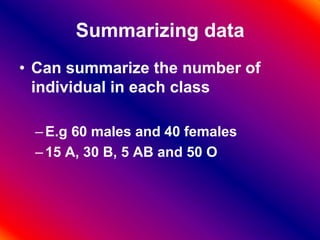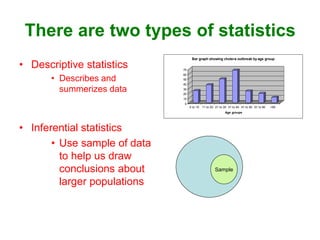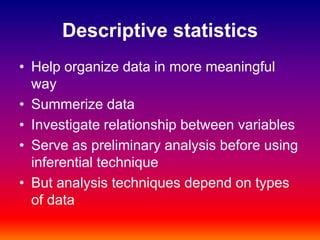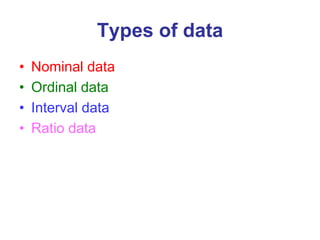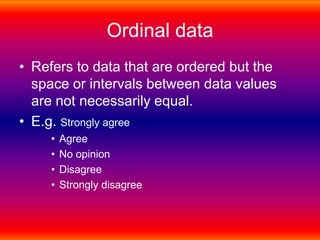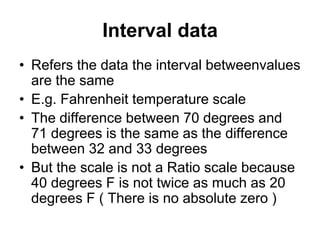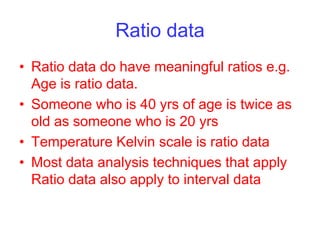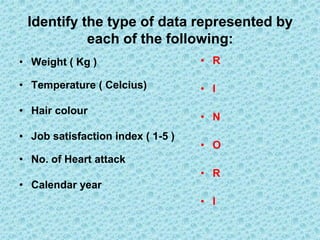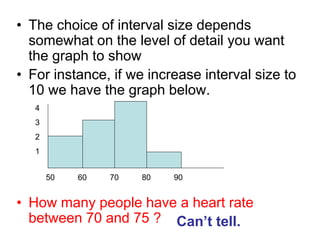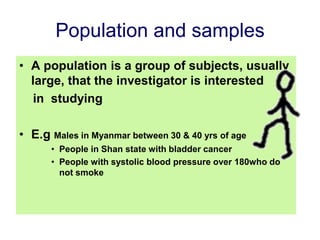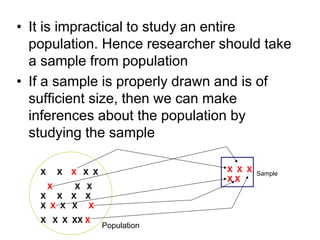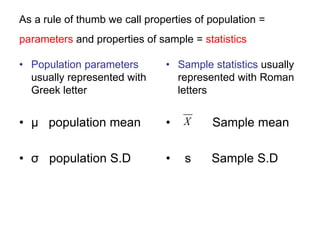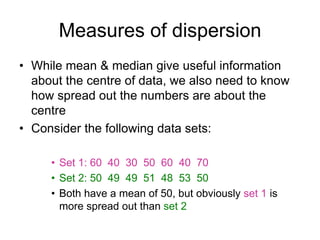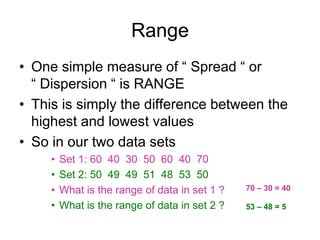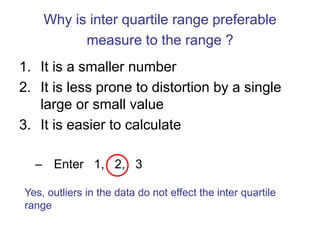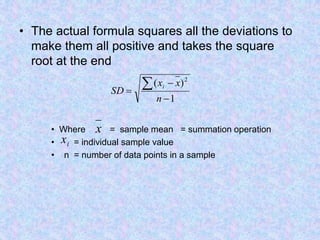IV STATISTICS I.pdf
- 2. Statistics • Is concerned with • Collecting • Organizing • Summarizing • Presenting and Analyzing data • To draw valid conclusions & making reasonable decisions on the basis of such analysis
- 3. Collecting data • Can collect data concerning –Characteristics of a groups of individuals or objects –E.g. 100 blood donors donate 100 bottles of blood in Blood Bank
- 4. Organizing data • Can organize data by classifying different groups – Sex and blood type of blood donors – E.g. Male, Female and A,B,AB & O
- 5. Summarizing data • Can summarize the number of individual in each class –E.g 60 males and 40 females –15 A, 30 B, 5 AB and 50 O
- 6. Presenting data • Can present data by rate, ratio, percentage, diagram ect • Male:Female ratio of blood donors = 3:2 • Percentage of Blood groups • A = 15 % • B = 30 % • AB = 5 % • O = 50 % 0 10 20 30 40 50 60 70 80 90 100 A B AB O A B AB O
- 7. Analyzing data • From presentation, the findings can be analyzed such as more male blood donors than female
- 8. There are two types of statistics • Descriptive statistics • Describes and summerizes data • Inferential statistics • Use sample of data to help us draw conclusions about larger populations 0 10 20 30 40 50 60 70 0 to 10 11 to 20 21 to 30 31 to 40 41 to 50 51 to 60 >60 Age groups Bar graph showing cholera outbreak by age group Sample
- 9. Clinical trial for Antihypertensive drug • Population with SBP = 180 mm Hg • Random sample = 10 patients • Give antihypertensive drug • After drug, sample mean SBP = 170 mm Hg • Can we conclude that the drug was effective not without a statistical analysis? • No (need to compute probability due to chance )
- 10. Descriptive statistics • Help organize data in more meaningful way • Summerize data • Investigate relationship between variables • Serve as preliminary analysis before using inferential technique • But analysis techniques depend on types of data
- 11. Types of data • Nominal data • Ordinal data • Interval data • Ratio data
- 12. Nominal data • Refers to data that represent categories or names • There is no implied order to the categories of nominal data • E.g. Eye colour • Race • Gender • Marital status
- 13. Ordinal data • Refers to data that are ordered but the space or intervals between data values are not necessarily equal. • E.g. Strongly agree • Agree • No opinion • Disagree • Strongly disagree
- 14. Interval data • Refers the data the interval betweenvalues are the same • E.g. Fahrenheit temperature scale • The difference between 70 degrees and 71 degrees is the same as the difference between 32 and 33 degrees • But the scale is not a Ratio scale because 40 degrees F is not twice as much as 20 degrees F ( There is no absolute zero )
- 15. Ratio data • Ratio data do have meaningful ratios e.g. Age is ratio data. • Someone who is 40 yrs of age is twice as old as someone who is 20 yrs • Temperature Kelvin scale is ratio data • Most data analysis techniques that apply Ratio data also apply to interval data
- 16. Identify the type of data represented by each of the following: • Weight ( Kg ) • Temperature ( Celcius) • Hair colour • Job satisfaction index ( 1-5 ) • No. of Heart attack • Calendar year • R • I • N • O • R • I
- 17. Frequency distribution • Useful method for summerizing data in graphic form • Suppose we want to investigate relationship between coffee drinking and heart rate ( pulse ) • First we need to know something about heart rates in a “ normal “ population • Next we define a population to investigate • E.g Males between 30 and 40 yrs in Myanmar • Take sample from population
- 18. • We find following 10 heart rates • 72,52,63,68,66,72,74,81,76,56 • A frequency distribution will help us to summerize these numbers and see patterns in the values • How many men had heart rate between 70 and 75? ______ 50 55 60 65 70 75 80 85 3 2 1 3
- 19. • The choice of interval size depends somewhat on the level of detail you want the graph to show • For instance, if we increase interval size to 10 we have the graph below. • How many people have a heart rate between 70 and 75 ? 50 60 70 80 90 4 3 2 1 Can’t tell.
- 20. Mean, Median and Mode • Mean = The arithmatic mean is synonymous with average and is the same calculation • E.g Mean heart rate sample is = 68.0 • The mean is common measure of central tendency 10 56 76 81 74 72 66 68 63 52 72 HR
- 21. Median • Median is the centre of the group of numbers. That is half the numbers will be above the median and half will be below • To calculate the median, we first to sort out data array. For the heart rate data: 72,52,63,68,66,72,74,81,76,56 • Sorting result in the following: 52, 56, 63, 66, 68, 72, 72, 74, 76, 81 • There is no middle number. In this case we take the mean of two middle numbers Median Thus what is median ? =70
- 22. Mode • The mode of the set data is the most frequently occurring number • When evaluating data the mode is rarely used • In heart rate data: • 52,56,63,66,68,72,72,74,76,81 • What is the mode ? 72
- 23. Mean = 68 Median = 70 Mode = 72 • As you can see the three measures of central tendency ( Mean, Median, Mode ) have different values • They are used in different statistical situations, depending on the nature of data and statistical tests to be performed.
- 24. Population and samples • A population is a group of subjects, usually large, that the investigator is interested in studying • E.g Males in Myanmar between 30 & 40 yrs of age • People in Shan state with bladder cancer • People with systolic blood pressure over 180who do not smoke
- 25. • It is impractical to study an entire population. Hence researcher should take a sample from population • If a sample is properly drawn and is of sufficient size, then we can make inferences about the population by studying the sample Population Sample X X X X X X X X X X X X X X X X X X X X XX X X X X X X
- 26. As a rule of thumb we call properties of population = parameters and properties of sample = statistics • Population parameters usually represented with Greek letter • μ population mean • σ population S.D • Sample statistics usually represented with Roman letters • Sample mean • s Sample S.D X
- 27. Measures of dispersion • While mean & median give useful information about the centre of data, we also need to know how spread out the numbers are about the centre • Consider the following data sets: • Set 1: 60 40 30 50 60 40 70 • Set 2: 50 49 49 51 48 53 50 • Both have a mean of 50, but obviously set 1 is more spread out than set 2
- 28. Range • One simple measure of “ Spread “ or “ Dispersion “ is RANGE • This is simply the difference between the highest and lowest values • So in our two data sets • Set 1: 60 40 30 50 60 40 70 • Set 2: 50 49 49 51 48 53 50 • What is the range of data in set 1 ? • What is the range of data in set 2 ? 70 – 30 = 40 53 – 48 = 5
- 29. • However you will find that the range is not often used, and for good reason it is too sensitive to a single high or low data value • Instead we suggest two alternatives: • Inter quartile range • Standard deviation
- 30. Inter quartile range • The inter quartile range is similar to the range except that it measures the difference between the first and third quartiles • To compute it, we first sort the data. • Then find the data values correspondingly to the first quarter of the numbers ( first quartile ) and then top quarter ( third quartile ) • The inter quartile range is the distance between these quartiles
- 31. • Given the following data set: 18 21 23 24 24 32 42 59 • We sort the data from lowest and highest • Find the bottom quarter and top quarter of the data • Then determine the range between these values • What do you get for the inter quartile range ? First quartile = 22 Third quartile = 37 13
- 32. Why is inter quartile range preferable measure to the range ? 1. It is a smaller number 2. It is less prone to distortion by a single large or small value 3. It is easier to calculate – Enter 1, 2, 3 Yes, outliers in the data do not effect the inter quartile range
- 33. Standard deviation • The most common used measure of dispersion is Standard Deviation • The S.D can be thought of as the “ average “ deviation ( difference ) between the mean of a sample and each data value in the sample
- 34. • The actual formula squares all the deviations to make them all positive and takes the square root at the end • Where = sample mean = summation operation • = individual sample value • n = number of data points in a sample 1 ) ( 2 n x x SD i x i x
- 35. • As an example , let’s compute the standard deviation of the four values • 1 3 5 7 • Step 1 – Calculate the mean = Σ x / n = 4 • Step 2 – Compute the deviation of each score from the mean Value Mean Deviation Step 3 – Square all deviations and add square deviation 1 4 -3 9 3 4 -1 1 5 4 +1 1 7 4 +3 9 20
- 36. • Step 4 – Divided by n – 1 = 20 / 3 • Step 5 – Take the square root Review • Step 1 – Calculate mean • Step 2 – Compute deviation • Step 3 – Square and sum • Step 4 – Divide by n – 1 • Step 5 – Take square root • By the way the quantity before we take the square root is called Variance • Variance = ( Standard deviation 58 . 2 3 / 20 2 ) x x xi 2 ) ( x xi ) 1 /( ) ( 2 n x xi 1 ) ( 2 n x xi




